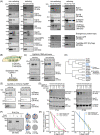Microscopic and biochemical monitoring of endosomal trafficking and extracellular vesicle secretion in an endogenous in vivo model
- PMID: 36103151
- PMCID: PMC9473323
- DOI: 10.1002/jev2.12263
Microscopic and biochemical monitoring of endosomal trafficking and extracellular vesicle secretion in an endogenous in vivo model
Abstract
Extracellular vesicle (EV) secretion enables cell-cell communication in multicellular organisms. During development, EV secretion and the specific loading of signalling factors in EVs contributes to organ development and tissue differentiation. Here, we present an in vivo model to study EV secretion using the fat body and the haemolymph of the fruit fly, Drosophila melanogaster. The system makes use of tissue-specific EV labelling and is amenable to genetic modification by RNAi. This allows the unique combination of microscopic visualisation of EVs in different organs and quantitative biochemical purification to study how EVs are generated within the cells and which factors regulate their secretion in vivo. Characterisation of the system revealed that secretion of EVs from the fat body is mainly regulated by Rab11 and Rab35, highlighting the importance of recycling Rab GTPase family members for EV secretion. We furthermore discovered a so far unknown function of Rab14 along with the kinesin Klp98A in EV biogenesis and secretion.
Keywords: Drosophila; Rab11; Rab35; Tsp96F; exosomes; fat body; haemolymph; intercellular communication.
© 2022 The Authors. Journal of Extracellular Vesicles published by Wiley Periodicals, LLC on behalf of the International Society for Extracellular Vesicles.
Conflict of interest statement
The authors have no competing financial interests.
Figures







Similar articles
-
Opposing functions for retromer and Rab11 in extracellular vesicle traffic at presynaptic terminals.J Cell Biol. 2021 Aug 2;220(8):e202012034. doi: 10.1083/jcb.202012034. Epub 2021 May 21. J Cell Biol. 2021. PMID: 34019080 Free PMC article.
-
The kinesin motor Klp98A mediates apical to basal Wg transport.Development. 2020 Aug 14;147(15):dev186833. doi: 10.1242/dev.186833. Development. 2020. PMID: 32665246 Free PMC article.
-
Coordination of autophagosome-lysosome fusion and transport by a Klp98A-Rab14 complex in Drosophila.J Cell Sci. 2016 Mar 1;129(5):971-82. doi: 10.1242/jcs.175224. Epub 2016 Jan 13. J Cell Sci. 2016. PMID: 26763909 Free PMC article.
-
Understanding extracellular vesicle diversity - current status.Expert Rev Proteomics. 2018 Nov;15(11):887-910. doi: 10.1080/14789450.2018.1537788. Epub 2018 Oct 23. Expert Rev Proteomics. 2018. PMID: 30326765 Review.
-
Biogenesis, Membrane Trafficking, Functions, and Next Generation Nanotherapeutics Medicine of Extracellular Vesicles.Int J Nanomedicine. 2021 May 18;16:3357-3383. doi: 10.2147/IJN.S310357. eCollection 2021. Int J Nanomedicine. 2021. PMID: 34040369 Free PMC article. Review.
Cited by
-
Microglial activation induces nitric oxide signalling and alters protein S-nitrosylation patterns in extracellular vesicles.J Extracell Vesicles. 2024 Jun;13(6):e12455. doi: 10.1002/jev2.12455. J Extracell Vesicles. 2024. PMID: 38887871 Free PMC article.
-
Filopodia are essential for steroid release.Nat Commun. 2025 Jul 1;16(1):5501. doi: 10.1038/s41467-025-60579-7. Nat Commun. 2025. PMID: 40593541 Free PMC article.
-
Oxidative stress-induced changes in the transcriptomic profile of extracellular vesicles.J Extracell Biol. 2024 Apr 21;3(4):e150. doi: 10.1002/jex2.150. eCollection 2024 Apr. J Extracell Biol. 2024. PMID: 38938847 Free PMC article.
-
Targeted delivery of extracellular vesicles: the mechanisms, techniques and therapeutic applications.Mol Biomed. 2024 Nov 21;5(1):60. doi: 10.1186/s43556-024-00230-x. Mol Biomed. 2024. PMID: 39567444 Free PMC article. Review.
-
Extracellular Vesicles in Arthropods: Biogenesis, Functions, Isolation Methods and Applications.J Extracell Vesicles. 2025 Sep;14(9):e70156. doi: 10.1002/jev2.70156. J Extracell Vesicles. 2025. PMID: 40903823 Free PMC article. Review.
References
Publication types
MeSH terms
Substances
LinkOut - more resources
Full Text Sources
Molecular Biology Databases
Research Materials

